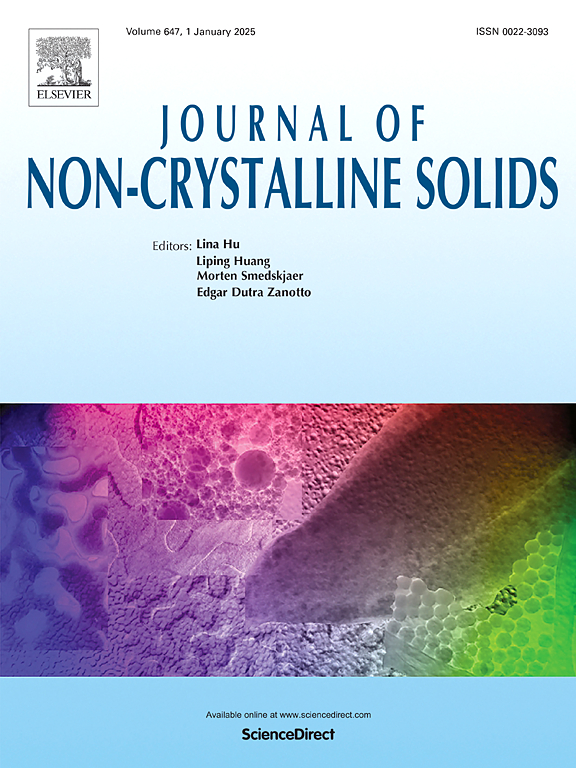添加W、Ni和P对铁基非晶合金非晶形成能力和性能的影响
IF 3.5
3区 材料科学
Q1 MATERIALS SCIENCE, CERAMICS
引用次数: 0
摘要
本文研究了不同W、Ni和P比对Fe50−x−yCr15Mo14C15−2/ 3zb6−1/3zWxNiyPz合金(x = 2,4,6 at)的非晶形成能力(GFA)、热稳定性、显微组织和耐腐蚀性的影响。%;Y z = 3,6,9 at。%)进行了系统调查。结果表明:W4Ni3P6合金的GFA表现最好,能产生平均厚度为57.67 μm的非晶态合金带;在三种元素中,W对fe基非晶合金热稳定性的影响最为显著,随着W含量的增加,玻璃化转变温度(Tg)和结晶温度(Tx)均升高。随着冷却速率的增大,W4Ni3P6合金的组织逐渐细化,最终形成完全非晶组织。元素分布变得越来越均匀,没有观察到明显的元素分离。W4Ni3P6非晶合金带在3.5 wt. % NaCl溶液中的耐蚀性显著提高。合金的自腐蚀电位约为−0.569 V,腐蚀电流密度约为3.227 × 10−6 A/cm²,钝化范围较宽。本文章由计算机程序翻译,如有差异,请以英文原文为准。
Effect of W, Ni, and P addition on the glass-forming ability and properties of Fe-based amorphous alloys
In this present paper, the effects of varying the W, Ni, and P ratios on the glass-forming ability (GFA), thermal stability, microstructure, and corrosion resistance of Fe50−x−yCr15Mo14C15−2/3zB6−1/3zWxNiyPz alloys (where x = 2, 4, 6 at. %; y, z = 3, 6, 9 at. %) were systematically investigated. The results indicate that the W4Ni3P6 alloy composition exhibits the best GFA, producing amorphous alloy ribbons with an average thickness of 57.67 μm. Among the three elements, W has the most significant impact on the thermal stability of the Fe-based amorphous alloys, with both the glass transition temperature (Tg) and crystallization temperature (Tx) increasing as the W content increases. As the cooling rate increases, the microstructure of the W4Ni3P6 alloy is gradually refined, eventually forming a fully amorphous structure. Element distribution becomes increasingly uniform, with no noticeable element segregation observed. The corrosion resistance of the W4Ni3P6 amorphous alloy ribbons in a 3.5 wt. % NaCl solution is significantly improved. Specifically, the self-corrosion potential is approximately −0.569 V, the corrosion current density is about 3.227 × 10−6 A/cm², and the alloy exhibits a wider passivation range.
求助全文
通过发布文献求助,成功后即可免费获取论文全文。
去求助
来源期刊

Journal of Non-crystalline Solids
工程技术-材料科学:硅酸盐
CiteScore
6.50
自引率
11.40%
发文量
576
审稿时长
35 days
期刊介绍:
The Journal of Non-Crystalline Solids publishes review articles, research papers, and Letters to the Editor on amorphous and glassy materials, including inorganic, organic, polymeric, hybrid and metallic systems. Papers on partially glassy materials, such as glass-ceramics and glass-matrix composites, and papers involving the liquid state are also included in so far as the properties of the liquid are relevant for the formation of the solid.
In all cases the papers must demonstrate both novelty and importance to the field, by way of significant advances in understanding or application of non-crystalline solids; in the case of Letters, a compelling case must also be made for expedited handling.
 求助内容:
求助内容: 应助结果提醒方式:
应助结果提醒方式:


